Original Bialetti vs. Cheap Chinese Stainless Steel Moka Pot. Tested
Comments: 25↓ specifications & manual ↓
Bialetti is a company that invented moka pots. However, today many other brands offer Italian stove top coffee makers for 2 or even 3 times lower price. Is there any real difference between them except the famous ‘little man with the mustache’ logo, which Bialetti proudly put on its models? (Spoiler: yes)
I decided to compare stainless steel versions, since my new kitchen is equipped with a induction stove (classic aluminium moka pots like Moka Express or Brikka can’t work with it). I choose a Bialetti Venus by Bialetti (‘Made in India according to Bialetti’s quality standarts’ was written on the box) and a similar moka pot by some unknown brand from China (almost 3 times cheaper). Both are for 4 cups, which equals to 160ml. Here they are:
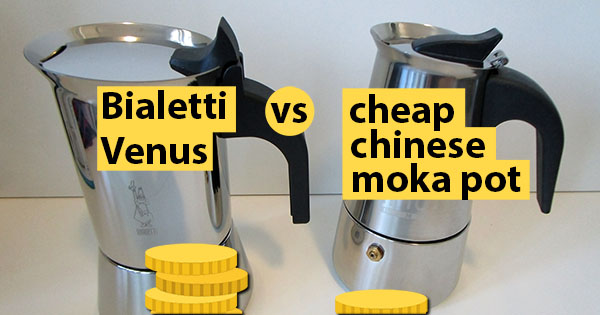
The Chinese moka pot that I bought is sold under different names in different countries. Usually it costs less than Bialetti’s one:
In the States you may find it in stock as a Stovetop Espresso by Túasia, AMFOCUS Stovetop Espresso Maker or VonShef Stovetop Espresso Coffee Maker. Similar Inox moka pots are sold also by Primula, BEMINH, Mixpresso Coffee, WeHome, MAYMII, MODIN and Maggift brands.
All these models as I assume are OEM manufactured products. The “original” noname Chinese coffee maker is available on Aliexpress.
Exactly the same model could be found in the UK. Here it is known as 6-Cup Espresso Coffee Maker by Kurtzy (ATWFS, Linaatales, Tooltime, KING HOFF and Yosoo sell identical stainless steel pot as well). On the German market and in other European countries it is known as Generic Moka Espressokocher, Cuigu Edelstahl Moka Pot, HuntGold or UniqueHeart. In Asia (Indonesia as an example) they don’t bother to invent brand names and sell it just as namless stainless steel moka.
If you will search for stainless steel moka pot on your local Amazon, then likely you will find more clones. They all look the same and, based on reviews anaysis, they all have similiar drawbacks, which I found in my specimen as well.
So let’s investigate the differences between cheap Chinese moka pot made of steel vs original Bialetti Venus. I will not describe the unboxing process (though Bialetti packaging was better) and focus on the materials, construction, coffee taste and temperature:
1. Materials used
Both coffee makers are made of stainless steel. However the thickness of the metal is different, Chinese one definetly has more slim edges (hereinafter on photos the Bialetti is on left while the Chinese one is on right):
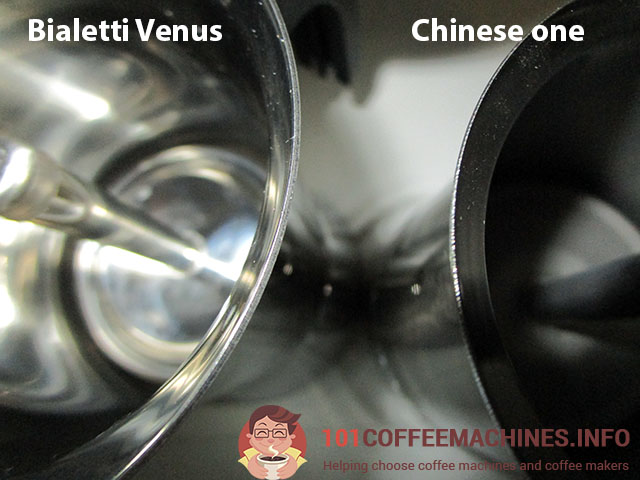
The fact that Bialetti uses a lot more metal while producing their stove top espresso makers is also proven by the weight. According to my kitchen scale it’s 544 grams (19.2 ounces) in the case of Bialetti vs 330 grams (11.6 ounces) in the case of its counterpart. Both measurements are made without boxes:

Different weight changes the brewing procces, by the way. I will describe it below.
❕ The main thing, that dissapointed me was the weirdly coated bottom section in Chinese moka pot. While the Bialetti has a equaly shiny polished steel both outside and inside, the bottom chamber of the second coffee maker has a layer of some strange material:
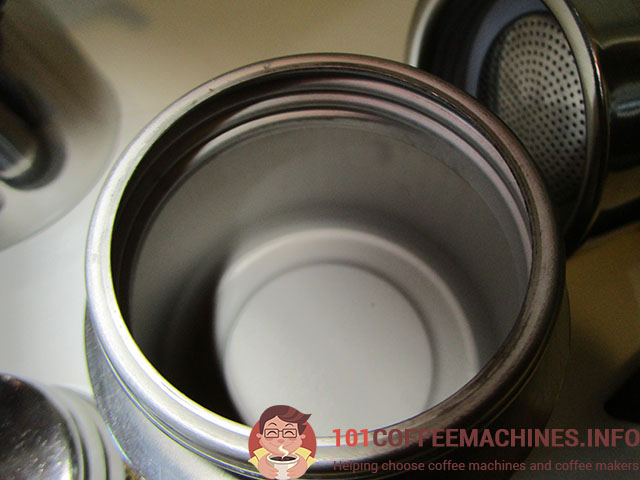
I made a brief analysis of reviews and customer photos of all above mentioned clones (Primula, AMFOCUS, VonShef , MODIN, Maggift etc). Other people report the same, so it’s not just because my specimen was defected.
Some people assume that it’s unbrushed steel. However, mainly due the specific smell (this fact itself could be listed in cons) I think that they put a layer of some non-stick coating inside. Either because it’s cheaper than polishing it from inside or because they use less chromium/nickel in the alloy (they are needed to make the metal stainless). That’s why inner parts that are constantly in contact with water have to be covered by some protective surface in order not to corrode.
Anyway, the reason why Chinese-made moka pot has this covering is not so important. What important is that there is some strange smelly thing inside, not just the shiny polished steel.
The same coating, but in less amount, could be noticed in the upper chamber as well. See photo below:
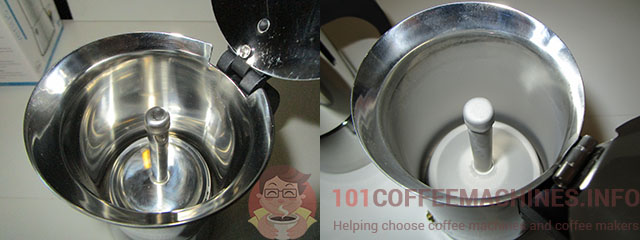
2. Construction
Generally the construction and design of both stove top makers are eqaul. Chinese one even has the identical funnel and gasket:
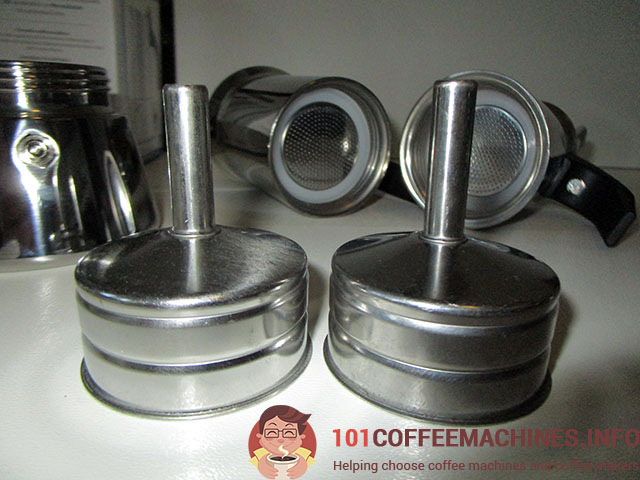
However, what is really terrible and annoying (even more than strange smelly internal surface) is the built quality and the plastic handle combined with the lid opener. Let me show it in details:
My Chinese moka pot (as well as Primula, ATWFS, Kurtzy and most of other clones, which apparently are made using the same technical process) has unfinished welding seam on the upper part that is visible from inside. The same defect was reported by other users, for example, you can notice this defect even on relatively well-rated model by VonShef (check on amazon):
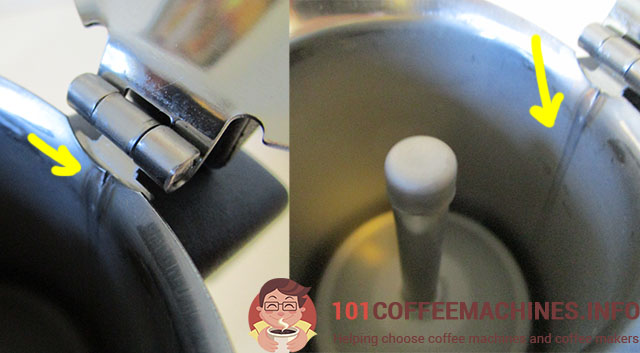
Needless to say that original Bialetti Venus doesn’t have such “scar”:
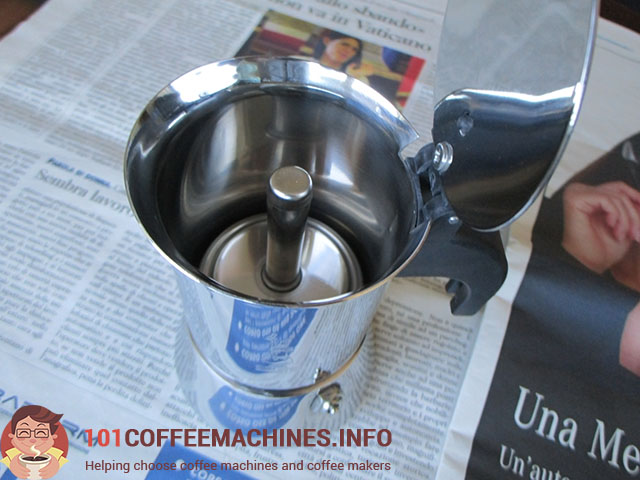
The flimsy plastic part, which is used as a handle and the opener for the upper lid on Chinese models, have folowwing drawbacks:
- It’s small and it’s uncomfortable to handle, morover, when you will try to use it as a lid opener, your thimb will likely touch the hot metal (at least you are not a child with small fingers)
- It’s attached with one(!) screw. No surpise, that users often report that the handle come off quickly.
- Finally the lid moves and sounds like a door of 40 y.o. Renault compared to any modern car:
My last observation is about emergency valve that is located one the side of the bottom chamber and that is used to lower the pressure if the funnel would be clogged. They are different:
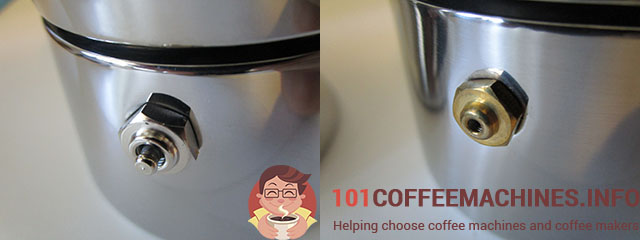
Bialetti uses a special anti-scale valve (on the left). That is how it’s described in the manual:
The Bialetti inspection valve is a patented valve, which has been designed to guarantee the use of the coffee maker in complete safety. Using the coffee maker with drinking water entails the risk of formation of lime scale in the hole of the safety valve, causing the clogging of the valve itself and the malfunctioning of the product.
With the Bialetti inspection valve, it is very simple to avoid clogging arising from lime scale: just move the small piston coming out of the valve along its axis when washing the coffee maker.
3. Taste and Temperature
As I mentioned above the fact that Chinese has thinner metal body affects the brewing proccess. Bialetti’s upper chamber stays cools longer, while all parts of Chinese coffee maker becomes hot very soon. That means that temperature of extraction is higher on Chinese one. It’s generally condidered to be bad for the coffee taste (because it may become bitter), however it’s better for lovers of hot coffee.
Here are photos of coffee temperature measurement in Bialetti Venus and in ATWFS moka pot just after brewing on gas cooker (photos kindly provided by my reader kroleg-m):
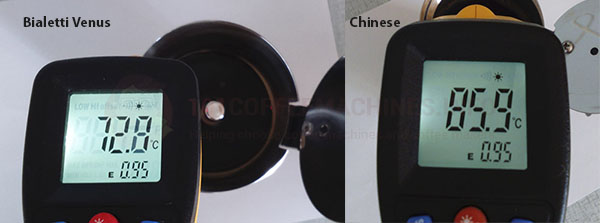
I NEED your opinion. Please rate my review:


 (20 votes, average: 4.65 out of 5)
(20 votes, average: 4.65 out of 5)



We have both Bialetti and Chinese. The Bialetti is much better built. The bottom of the Chinese one has blown into a dome which means it rocks on any flat surface , such as our flat cooker plates. So now useless.
Paul
31 Aug 18 at 8:27 am
Thanks for the review.
So, is there any difference in taste if everything else (water starting temperature, coffee amount, heating) being equal?
Viacheslav
23 Sep 18 at 6:24 am
Another question is on the gasket: has the Venus the same rubber one as other aluminum Bialetti models which need replacement time to time or a silicone one as in Chinese stainless mokas?
Viacheslav
23 Sep 18 at 9:58 am
What about other Italian moka pot producer like Pedrini? Can you compare Bialetti and Pedrini? I want to know since Pedrini is cheaper than Bialetti.
Ranu
5 Apr 19 at 8:38 am
Hi, Ranu. Pedrini produces its moka pots in China, some of Bialetti’s moka pots are made in Italy (uncolored Moka Express and some limited series), others in Romania (all aluminium models) or India (all stainless steel models). In China they made only Junior Express (sub brand of Bialetti) and Kitty Nero. Plus Pedrino has a simple emergency valve, while Bialetti has improved one, which is more resistant to scale (but, honestly, it’s important only if you have very hard water). Nevertheless, Pedrini pots are still good, no smells or bad materials used like in some cheap Chinese coffee makers.
So… If you need just a decent moka pot and don’t want to pay extra for the brand, for the classical design and for the proudly printed words “Made in Italy”. Then you may go with Pedrini 🙂
P. S. You can check also Top Moka – another Italian brand with cheaper mokas. They have special shape of the bottom parts, which is claimed to heat the water faster. But I never tested it personally. And they still make it in Italy.
Dmitriy
5 Apr 19 at 2:47 pm
I see.. thanks for the detailed answer. What about the Bialetti Break? I notice that it’s the cheapest series from Bialetti. Is it made in China as well?
Ranu
8 Apr 19 at 12:49 pm
It is made in Romania. At least one year ago it was like that, unlikely that something changed.
Dmitriy
8 Apr 19 at 4:27 pm
Dmitry, thanks for the answer. I just bought Pedrini 3 cups today. And like you wrote, it was made in China. However, I liked it. Previously, I bought a cheap moka pot that was made in Korea. Pedrini looks better than the cheap one. You were right. No smells and it has better materials.
Ranu
9 Apr 19 at 4:08 pm
Thanks for detailed review. Always wondered why my cheap noname chinese moka pot makes so bitter coffee, and tried to do something about it, getting it off the stove sooner than steam would come out. Turns out, I’d better change it at all. (so I did, and chose espresso maker). But, if I ever need moka, now I know what to buy.
Asviar
18 Apr 19 at 3:56 pm
Best comparison article I’ve read so far. Can you please suggest any other “made in Italy” descent brands, made of stainless steel, that can be found on Amazon? The top moka you mentioned in another answer, isn’t stainless steel
Streetlight
21 May 19 at 11:06 am
I’m afraid that the only truly “made in Italy” stainless steel moka pots are by Alessi. By the way, Alessi was a grandson of Mr. Bialetti, so these companies have strong family ties 🙂 The only problem is that Alessi’s moka pots are pricey, because they are specialized on top-notch coffee makers designed by famous artists. But it’s 100% Italian. They have three series of steel moka pots:
Model 9090: https://amzn.to/2Hu5LDh https://amzn.to/2M00bwr
La Cupola: https://amzn.to/30BQOqi
La Conica: https://amzn.to/2VE79qo
P. S. If you are also considering decent Italian brands, but with steel production in China (except Bialetti) then you can check Pedrini https://amzn.to/2JOTyum I would trust this brands, however, they also moved factories outside Italy.
Dmitriy
21 May 19 at 12:34 pm
Update. Found one more original “made in Italy” moka pot on Amazon https://amzn.to/2XB6Oda
Dmitriy
25 Jun 19 at 3:18 pm
I just bought it from amazon.ca and the package outside said it is developed and designed in Italy but made in China. I never bought a Bialetti before but for the price I paid for it’s craftsmanship is a little disappointing. The two parts where they screw in together is not finished smoothly. I can feel ripples along the inside edge. I am wondering like you said be wary of it being made in China. Do you know if the current ones are manufactured in China now? The one I bought is sold directly by amazon and not third party.
Wallace
11 Jul 19 at 2:36 am
Bialetti Venus? The one that we have here in Europe are still have “Made In India” labels. The Kitty is made in China, indeed.
Dmitriy
18 Jul 19 at 2:18 pm
Wallace, I’ve had the same experience: there is a clear difference between Chinese or Romanian made Bialettis’ and the Italian ones’ quality. I’ve bought my Italian Moka Express in a small gourmet shop of an Italian guy. In large stores (even big names) I’ve only found the abroad-produced moka pots so far. They are cheaper compared to their Italian brothers but yet no budget solution. You chose a brand like Bialetti for it’s well known quality, right? It’s nowhere written that their coffee makers differ depending on where they come from but you can easily tell when you hold both in hand.
I’m happy that this topic came up because I wanted to share my experiance. I’ve met no discussions about it so far.
Thank you for the detailed test, Dmitriy! It’s a missing piece of the story!
Adel
11 Sep 19 at 4:48 pm
I bought a Chinese pot and found exactly the same as described in your article. It was made so poorly, the coffee leaked back into the lower pot after it brewed. The non-stick chemical coating has NO place in food-grade cookware.
Do yourselves a favour, ignore those cheap crappy chinesium made products, you will always be disappointed at their half-life and you are lucky if your lips don’t fall off from the chemicals used.
oscar
23 Oct 19 at 7:34 am
I bought a Bialetti Venus and it says on the box “Developed and designed in Italy / Made in China”. It has the strange coating on the bottom part only. Does anyone know what that is? It is disappointing that they now seem to make it like the cheap Chinese ones.
Krasi
25 Nov 19 at 1:39 pm
How does it look? You may send photos to [email protected], I will attach it to your comment.
p.s. wordpress doesn’t allow to attach images to comments by default, I’ll try to figure out how to improve it.
Dmitriy
25 Nov 19 at 2:53 pm
Thank you for such a brilliant review. I ordered a Bialetti pot from a very ‘high end’ store here in Ireland – and paid a lot of money for it. I bought a 6 and 4 cup expresso maker. Online it stated it was ‘top quality stainless steel’. Once I opened the box I could tell it was not the case. The weight of the pot is very light, there’s a weird coating on the interior and no where on the pot does it state ‘stainless steel’. On the box it says ‘made in china’ and it also says ‘The manufacturer reserves the right to make aestheical or technical changes without notice’ in VERY small print. What does that mean ? Is this really stainless steel? I feel I have been sold a dud. The coffee tastes very different in cheap pots but also the chemicals they are layering on are shocking. Thankfully I have not used the pots yet and thanks to your review I’ll be on the hunt for ‘made in Italy’ only from now on. Very disappointed by Bialetti and the fact the every store here is ‘selling stainless steel’ coffee pots that are made in China but it does not state on the pot that it is stainless steel. In fact in one store the pot on display said ‘stainless steel’ but the ones only available for purchase had no such markings !! I smell a very dodgy coffee.
Sinead
30 Aug 20 at 6:20 am
Even some of the Alessi Moka Pots are made outside Europe, (Ghana), I have a Giannina all stainless steel Moka Pot entirely made in Italy, beautiful, quirky, and 3 times the price of other stainless steel pots. In my opinion worth every penny. I use it every day.
Will
27 Jan 20 at 8:34 am
Thanks for additional information, Will!
Dmitriy
27 Jan 20 at 9:25 am
Thank you for this right up, however i have a question, My moka pot is from G.A.P it seems like it’s italian, but it has some similarities build wise as to the chinese model you reviewed. I can’t for the life of me make the coffee flow out of it smoothly, it always starts bubbling right away and spurting coffee in droplets, its always bitter. I tried not filling the basket to the brim with no avail, if I fill it to the brim without packing it clogs and coffee doesn’t even come out. Is there such a thing as a “so much fake it doesnt work at all” moka pot?
Lock
17 Jun 20 at 2:50 pm
Thank you for such an extensive review and comparison. I am on hunt for my 1st moka pot and aim to buy quality. Looks like Made in Italy Bialettis are difficult to find those days.
Marta
9 Jul 20 at 11:03 am
Hi, love your blog!
Just chirping in that I bought a 4 cup Bialetti Moka Express here in Berlin and the words on the box state:
“Designed and developed in Italy
Made in Italy”
So maybe (referring to the above comment) in Canada etc they sell ones which are made in China? Dissapointing how we outsource almost everything, live with poor quality and buy thrice rather than once
Dee
14 Jul 20 at 11:57 am
Hey Dmitriy,
How useful! Thanks!
I just bought a stainless steel Bialetti Venus 2 cup and it also has this strange coating in the bottom part. It says “Developed and designed in Italy / Made in China” on the box.
I also found stange that the upper part has a carved logo, while the bottom has just a printed one with no stainless steel sign.
Dee, the one you bought, made in Italy, does it have this coating too or not?
Athina Karvouni
27 Jul 20 at 3:15 pm